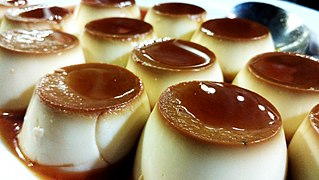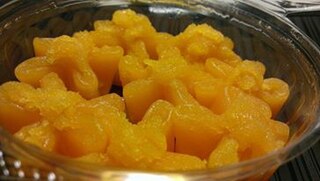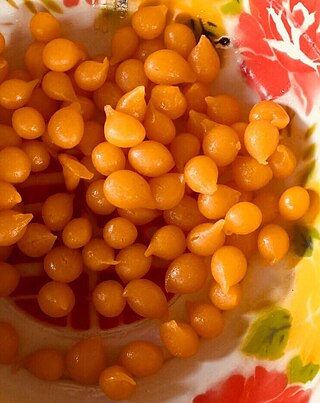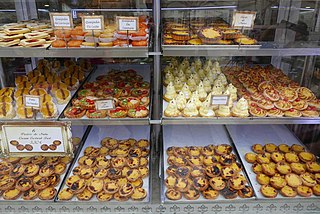
Crème caramel, flan, caramel pudding, condensed milk pudding or caramel custard is a custard dessert with a layer of clear caramel sauce.

The oldest known book on Portuguese cuisine, entitled Livro de Cozinha da Infanta D. Maria de Portugal, from the 16th century, describes many popular dishes of meat, fish, poultry and others.

Quindim is a popular Brazilian baked dessert with Portuguese heritage, made chiefly from sugar, egg yolks and ground coconut. It is a custard and usually presented as an upturned cup with a glistening surface and intensely yellow color. The mixture can also be made in a large ring mold in which case it is called a "quindão" and served in slices.

Papo de anjo or papo-de-anjo, roughly translated as "angel's double chin", is a traditional Portuguese dessert made chiefly from whipped egg yolks, baked and then boiled in sugar syrup.

Torta caprese is a flourless Italian cake made with chocolate and either almonds or hazelnuts. Named for the island of Capri from which it originates, the cake is widely known and especially popular in nearby Naples, Italy.
Maria Guyomar de Pina, Thao Thong Kip Ma, was a Siamese woman of mixed Japanese-Portuguese-Bengali ancestry who lived in Ayutthaya in the 17th century. She became the wife of Greek adventurer Constantine Phaulkon.

Sponge cake is a light cake made with eggs, flour and sugar, sometimes leavened with baking powder. Some sponge cakes do not contain egg yolks, like angel food cake, but most of them do. Sponge cakes, leavened with beaten eggs, originated during the Renaissance, possibly in Spain. The sponge cake is thought to be one of the first non-yeasted cakes, and the earliest attested sponge cake recipe in English is found in a book by the English poet Gervase Markham, The English Huswife, Containing the Inward and Outward Virtues Which Ought to Be in a Complete Woman (1615). Still, the cake was much more like a cracker: thin and crispy. Sponge cakes became the cake recognised today when bakers started using beaten eggs as a rising agent in the mid-18th century. The Victorian creation of baking powder by English food manufacturer Alfred Bird in 1843 allowed the addition of butter to the traditional sponge recipe, resulting in the creation of the Victoria sponge. Cakes are available in many flavours and have many recipes as well. Sponge cakes have become snack cakes via the Twinkie.

Bua loi or bua loy is a Thai dessert. It consists of rice flour rolled into small balls, and cooked in coconut milk and sugar. Some Bua loi also adds sweet egg into the recipe. It was inspired by Tangyuan, a Chinese dessert that is traditionally eaten around the Lantern festival. Bua Loi also traditionally eats at the Dongzhi Festival in Thailand, which is festival for the Chinese-Thai bloodline. There are a variety of versions of Bua loi such as using food coloring instead of natural color, using soy milk instead of Coconut cream, sliced Pumpkin to add inside rice balls, et cetera. There's other type of Bua loi in other country from China, Japan, Indonesia, Myanmar, Philippines, Southern Vietnam and Malaysia. 1 cup of Bua Loy has total calories of 295.5 kilocalories, protein of 10.4 grams, carbohydrate of 6.3 grams, and fat of 25 grams.

Thong yip or pinched gold egg yolks is one of the nine auspicious traditional Thai desserts. It is usually made for important occasions and ceremonies such as weddings, ordinations, and housewarmings.

Thong yot, also known as "gold egg-yolks drops", is an ancient Thai dessert and one of the nine auspicious traditional Thai desserts. Thong Yot originated in Aveiro District, Portugal. Thong Yot was adapted from ovos moles de aveiro, a Portuguese dessert, by Maria Guyomar de Pinha, who was appointed as a cook in the palace in the period of King Narai of Ayutthaya. Thong Yot is made from egg yolks, flour and sugar.

Thong ek, also known as "Wheat Flour Dumplings with Egg Yolks", is one of the nine auspicious traditional Thai desserts. It is a golden sweet carved as various types of flowers decorated with a piece of gold leaf on top, popularly served in very significant occasions such as career advancement ceremonies.
Doce de ovos is a sweet egg cream from Portuguese cuisine made with egg yolks and simple syrup. It is used as a filling for layered sponge cakes, and can be used as a sweet topping for ice creams and other desserts like Natas do Céu. The cream must be prepared at low temperature or in a bain marie to prevent the egg yolks coagulating.

Conventual sweets are a typical part of the Portuguese cuisine and a generic term to a variety of sweets in Portugal. As the name implies, conventual sweets were made by nuns who lived in the Portuguese convents and monasteries. Starting in the 15th century, these sweets have since integrated in the Portuguese cuisine and in former Portuguese colonies. Conventual sweets have sugar, egg yolks and almond as ingredients of choice.

Pão de Rala is an historical conventual dessert created by the Poor Clare nuns in the Convento de Santa Helena do Calvário in Évora. It is often accompanied by olives shaped out of marzipan and dusted with cocoa, per legend.

Sericaia is a Portuguese pudding similar to a soufflé, from Elvas, Alentejo. It is often accompanied with stewed Reine Claude plums grown in the region.

Encharcada is a traditional Portuguese conventual sweet of egg yolks boiled in sugar syrup and then broiled.
















